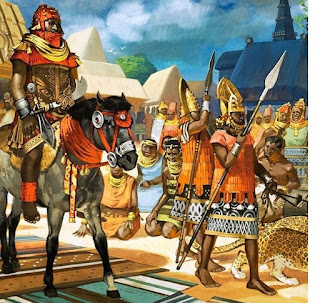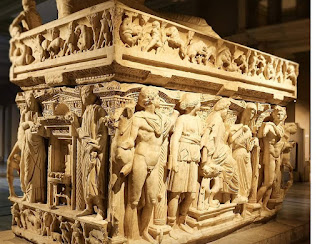Chapter 16, the Reign of Erian: Part 4
Erian the Able, 3rd Grand Prince of the Kingdom of Aerdy
Born -253 CY, Died
-181 CY
Reigned -198 to -181
CY
 |
| A lowland Flan king of the Achik tribe c. -185 CY Art by Angus McBride |
 |
| Saint Matea, Apostle of Sol to the Flan c. 5th century OR Art by Marat Ars |
 |
| The Royal brothers, Gennor and Nalaster on campaign against the Northern Flan, -182 CY Edward Atterton and Michael Vartan in Mists of Avalon |
 |
| Slaughter of the Royal grandchildren of Grand Prince Erian, -181 CY Jacobus de Voragine, "Massacre of the Innocents" in the Golden Legend (Legenda Aurea), 13th century |
Art Notes:
A lowland Flan king of the Achik tribe c. -185 CY Like many of the tribal leaders and nobles of this area, this petty king and his nobles and guards are heavily draped in gold and gold-plated jewelry. The Achik were one of the members of the Sim’chian Confederation who lived on the west bank of the Flanmi in a section of that river known for being particularly rich in gold and which still bears the name the Nugget Run(1). The armor of the king and his guards is a form of stitched brigandine of bronze plates between saffron-dyed fabric and in the case of the king, a rare reddish orange-dye extracted from a type of beetle native to the Adri Forest. In addition the king wears a bronze breastplate. The helmets of the guards are gold-plated and are for ceremonial purposes only although the helmets worn in battle are of a similar though plainer design and made of bronze. The king’s armor features a raised gorget to protect his neck and lower face while the helmets of the guards have aventails serving the same purpose. The weapons are of steel of a kind noted for its quality surpassing that even of Aerdy smiths of the time. It is believed that the Flan smith learned their methods via transmission from Flan tribes living closer to the Rakers who in turn learned their techniques from Dwarven smiths of the Kingdom of Gyrth Orom(2). The guard to the fore holds the leashes of a pair of tame leopards, a variety of large cat which are native to and still found in the deep Adri, and were also found in the Grandwood before they were hunted to extinction there(3).
Saint Matea, Apostle of Sol to the Flan c. 5th century OR The daughter of an important Thellari noble family near Rel Deven in what was then the Kingdom of Thalland. Matea was born just at the end of the civil conflict known as the War of the Three Brothers. Around -210 CY, after the Kingdom of Aerdy had conquered the southern Thellari Kingdom, her family tried to force her into an arranged marriage with a Torquann. Instead, she escaped to the sanctuary of the Temple of Lothan outside of Rel Deven(4) and took the vows of a priestess of the relatively obscure cult of Sol. Rather than absorb herself in obscure rituals of devotion to the fabled Orb of Sol, whose sanctuary the temple was(5), Matea went out among the common farmers of the surrounding land where she soon became known for her generosity and defense of the downtrodden. Taking up the life of a wandering mendicant priestess, her journeys took her north to Rel Astra. Around -200 CY she took her ministry to the lands of the Flan tribes of the northern Flanmi Valley among whom she found a ready flock, steeped as they were in the worship of Pelor. Her years among them laid the foundation for the merging of the two aspects of the Sun God into one. She spent the rest of her life among that people as they were slowly absorbed by Aerdy. By the time of her death in -126 CY at the age of almost 100, the cult of the god then known as Sol-Pelor had grown considerably in size and stature. When the Great Kingdom was founded not many years later, Overking Nasran called for a synod of the various major cults to convene and standardize the workings and order of the official Pantheon of the Great Kingdom, and he named that of Sol-Pelor to be one of them, alongside Heironeous, Hextor, Zilchus, Procan, Pholtus, Stern Alia, and the Velaeri.
The Royal brothers, Gennor and Nalaster on campaign against the Northern Flan, -182 CY The sons of Erian wear functional leather armor with an added layer of small, leather and metal plates attached to the under-layer with rivets that provide slightly better protection than plain leather but do not overlap like scale armor. This style is what is often referred to as studded leather armor(6). The examples they wear are more decorative than most. It is well-suited to the swift raiding style of warfare that was most often practiced during these campaigns. In the event of a set battle they would wear the more protective chainmail hauberk with sleeves reaching to the elbows and covering the mid-thigh that was becoming the norm for knights in this period. The horsemen behind them wear conical helms with a nasal guard and a chainmail or leather coif. This style had almost fully replaced the conical helm with cheek-plates and the flare-brimmed helm that had been popular for the last half century, and would be the standard for the next two centuries. Gennor was sometimes nicknamed the Fair, like his uncle Mikar, having inherited the blond hair of his Suloise grandmother.
Slaughter of the Royal grandchildren of Grand Prince Erian, -181 CY This scene is from an illuminated manuscript from the 4th century, Annals of the Grand Princes of the Kingdom of Aerdy, by Edron Grelden. The armor and clothing of those depicted is anachronistic, appearing as what was typical of the time in which this scene was illustrated. The villainous Baldo directs his knights in the murder of Grand Prince Erian’s grandchildren after tearing them from the arms of respectively, their grandmother, Princess Consort Florula and her daughter-in-law, Princess Corvata of Cranden, wife of Prince Gennor and daughter of the Duke of Oldridge. Princess Marberga of Zelrad, wife of Prince Nalaster was saved from death, having been out of the city on pilgrimage to Ountsy, the location of the nearest temple devoted to her patron deity, Wee Jas. A storm delayed her return when it forced her ship to take shelter in the coastal village of Baizel, midway between Ountsy and Rel Astra. The depiction here of the Princess Consort Florula is inaccurate. Though it is true that Nalaster and Marberga’s young son, Docos had been left in her care, when she saw her husband stabbed and realized their imminent fate, she wrested a sword from one of Baldo’s guardsmen and killed three Naelax soldiers before being cut down herself.
End Notes:
1. Ivid the Undying (IVID), p. 56. “Pronounced ‘eye-wish,’ this village of 450 is named after the old lament ‘I wish...’ once heard so often among the gold-fevered river panners who came late to the Nugget Run of the upper Flanmi in the second and third centuries. For a time, sizeable gold nuggets could be found by panning the fine stone and silt of the bed.”
2. Races of Greyhawk. “-2591 A treaty of mutual aid between the Lyrkerami of (the) Rakers and their noniz neighbors is signed at Gyrth Orom, the Bronze City, first dwur citadel founded in the low heights of (the) Rakers (hex R2-61).”
3. Leopards may seem out of place in this area but historically in the real world they ranged into the Caucasus region and as far north as northern China and Korea before becoming extinct in those areas, and they are still found in Northern India. The Dungeon Master’s Guide, 1st edition, p. 187 also lists leopards as a possible encounter in the encounter chart for Temperate Conditions, Faerie and Sylvan Settings.
4. Living Greyhawk Journal # 6/Dragon # 290, p. 102. “Instead of riding out to confront their rivals at Morshaldin Castle, ancestral headquarters of the Knight Protectors, Lord Kargoth’s plan called for a raid on the obscure Temple of Lothan near Rel Deven.”
5. Living Greyhawk Journal # 6/Dragon # 290, p. 102. “Kargoth informed his conspirators that the temple was the secret hiding place of legendary Orb of Sol, a holy artifact of great symbolic importance to the Aerdi people.”
6. There’s long-standing debate about studded leather armor. The most common idea is that it was originally the misinterpretation of illustrations of brigandine armor as being leather armor reinforced with studs, which would not provide much more additional protection than leather armor. To equal one extra point of armor I interpret it as described above rather than the official description in the 5e Players Handbook, “Made from tough but flexible leather, studded leather is reinforced with close-set rivets or spikes.” I would count any leather armor made thicker but still with flexibility by using additional plates of leather whether as scales or plates as being in the same armor class.



Comments
Post a Comment